
By Michiyo Miwa
An English Translation of a chapter in: Michiyo Miwa,
“Forms of Pray (祈りのかたち,
Inori no katachi)”, published from Jomo Newspaper Co. 10 Sept 2021, ISBN-13:
978-4863522923)
Translated by Dr. Masatoshi Iguchi, January 2022
It was only about ten years ago that I learnt that a statue of the God of Sericulture was enshrined in the immediate vicinity of my place. My daughter’s nursery school had made the connection for me. At that time, my daughter attended a nursery school, run by Meishoin (明照院), a Tendai Sect temple, in Shimonita Town, Kanra District, Gunma Prefecture. One day I had an opportunity to see the Buddha statue, the principal idol of the temple, and visited there.), a Tendai Sect temple, in Shimonita Town, Kanra District, Gunma Prefecture. One day I had an opportunity to see the Buddha statue, the principal idol of the temple, and visited there.
After watched the Buddha statue for a while, I looked into its rear side and sighted a quiet female statue. The chief priest told me it was the Goddess of Sericulture, or the Silk God.
I was aware of the fact that there was a statue of Bodhisattva for sericulture worship but this was the first time I saw an actual statue. A god of approximately 30 cm high, who stood on a pedestal with a relief of horse on it, held a pile of silk fabric on top of her head and leaves of mulberry in her hand.
I supposed it was a work of Meiji or Taisho Era. Although the colouring of some parts on the surface was peeled off and some parts of the figure were broken and missing, it was an elegant statue with a faint smile.

|
Figure 1 |
I think the person who made it was a puppet craftsman who usually made Hina dolls [1] because, from the late Edo period to Meiji - Taisho Eras, demands for Buddha sculptors were meagre, hence Buddha statues were presumably made by the hand of puppet craftsmen.
Why the God of Sericulture as such had existed?
A silkworm is a creature that is difficult to be reared because it is vulnerable to heat and cold, and delicate to humidity. The farmers’ job is to rear such silkworms by feeding mulberry leaves over several months to let them spin cocoons until they ship the cocoons to the factory.
In this course, it is unpredictable whether silkworms would not die of disease, or whether the mulberry, annihilated by thunder and hail. Also, the damage caused by rats that eat silkworms was serious, so that the yield of cocoons varied from year to year.
The rearing of silkworm was a gambling-like job, as is said that “Rearing O-kaiko [2] (silkworm) is a task that one can venture only at the risk of one’s life.” Whether the livelihood of silk farmers could be sustained depended on the silkworms called Okaiko-Sama [3]. Due to the anxiety that could not be helped by themselves, the farmers had no choice but to pray to the deity of sericulture for the safety and abundant harvest.
People involved in sericulture had erected memorials for silkworms that had died for disease, and worshiped the stone statues and slabs of silkworms, as well as of silk god, for abundant harvest. There were also votive tablets and stickers for praying for silkworms.
I think that sericulture worship had naturally arisen from the dearest and simple wish of farmers.
The origin of the silkworm in the myth
The history of sericulture is pretty old, and said to have begun with the cultivation of rice, as the origin of silkworm was described in Nihon Shoki (日本書紀) [4] and Kojiki (古事記) [5] complied in the 7th century.
According to Nihon Shoki, Lord Tsukuyomi (月夜見命, Tsukuyomi no Mikoto) had visited Lord Ukemochi (保食命, Ukemochi no Mikoto), who controlled food, by order of the Supreme Lord Amaterasu (天照大神, Amaterasu Ōmikami). Lord Ukemochi prepared a set of dishes, spitting rice, fish, and meat from his mouse to provide the best hospitality., Amaterasu Ōmikami). Lord Ukemochi prepared a set of dishes, spitting rice, fish, and meat from his mouse to provide the best hospitality.
Lord Tsukuyomi who was watching this became enraged and, saying, “Do you want to feed me the dirty things that you spit out from your mouth?”, pulled out his sword and killed Lord Ukemochi. After that, Lord Amanokumahito (, “Do you want to feed me the dirty things that you spit out from your mouth?”, pulled out his sword and killed Lord Ukemochi. After that, Lord Amanokumahito (天野熊人命) went to the place of Lord Ukemochi by order of Lord Amaterasu, and saw various things were borne out of the body of Lord Ukemochi, e.g., a cattle and a horse from the head, millet from the forehead, silkworms from the eyebrow, awa (Japanese millet) from the eyes, rice plant from the belly, and wheat, soybeans and red beans from the pubic place.) went to the place of Lord Ukemochi by order of Lord Amaterasu, and saw various things were borne out of the body of Lord Ukemochi, e.g., a cattle and a horse from the head, millet from the forehead, silkworms from the eyebrow, awa (Japanese millet) from the eyes, rice plant from the belly, and wheat, soybeans and red beans from the pubic place.
When Lord Amanokumahito brought them back, Lord Amaterasu rejoiced and used the grains as seeds to be sawn in the fields as food for people to live on. When Lord Amaterasu put the silkworm in his mouth, thread was ejected. This was said to be the beginning of sericulture.
A similar story is found also on Kojiki, although the gods that appeared were different.[6]
Thus, Sericulture has already been practiced in Japan since before the 7th century. Judging from the fact that the origin of sericulture was purposely written in the Nihon Shoki and Kojiki, one can recognise that sericulture was already an industry that was familiar to people at that age.
Sericulture worship in Gunma Prefecture
My daughter’s nursery school triggered me to face the Silk Goddess but at that time I had little knowledge about the deity of sericulture. My only connection to silkworm before then was that in my childhood I had helped to feed mulberry leaves to silkworms at my grandmother’s house in Nanmoku Village, Kanra District.
Nevertheless, ever since I knew the Silk God, I became intrigued in the sericulture deity depicted in both tangible and intangible forms that had been the spiritual object of people who were engaged in sericulture. Around that time [7], “Tomioka Silk Mill (富岡製糸場) and Related Sites” was selected in the provisional list of World Heritage and the silk industry in Gunma Prefecture began to attract attention.
With my sense of mission as a sculptor, I had started a research on how sericulture was protected as cultural properties.
Then, in a hope to obtain some clues. I visited Mr. Eiichi Sakamoto who lived in Annaka City. Mr. Sakamoto was the author of “Sericulture Gods”, published in 2008 from Gunma Prefecture Cultural Business Promotion Association. He told me about a the statues of Memyo Bodhisattva (馬鳴菩薩) existed in various places in Gunma Prefecture, and a number of monuments of Kinugasa Myojin) existed in various places in Gunma Prefecture, and a number of monuments of Kinugasa Myojin [8] (絹笠明神), as well as Cat Stones (根子石) in Annaka City, etc. The Cat Stones were enshrined as the natural enemy of mice in Sakisaki Shrine (咲前神社).) in Annaka City, etc. The Cat Stones were enshrined as the natural enemy of mice in Sakisaki Shrine (咲前神社).
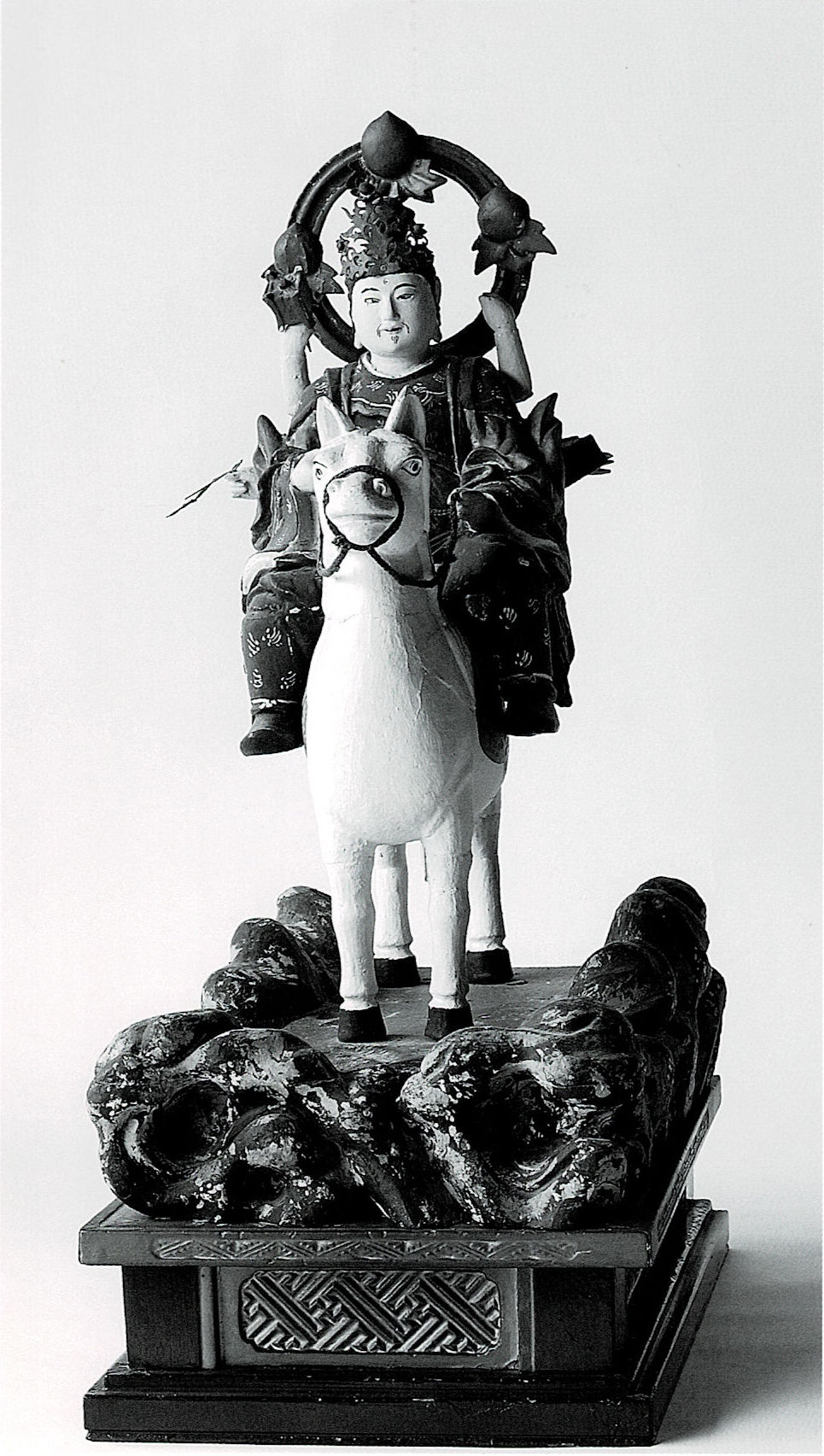
|
Figure 2 |

|
Figure 3 |
Memyo Bodhisattva, a bodhisattva derived from Chinese folk religion and known as a Buddha who gave clothes to poor people, was also worshipped as a deity of sericulture. It is said that the god was introduced into Japan with the transfer of Buddhism [9].
A bodhisattva with one face and six arms who mounts on the horseback was depicted as a figure holding a thread frame, thread, a scale and other items that related to sericulture and fabrics. The deity of sericulture that historically began with Memyo Bodhisattva was inherited in the early modern period in the form of goddess enshrined in Meishoin Temple in Shimonita Town, and worshiped. I would assume the fact that the deity was depicted as goddess was related to, or influenced by the fact that the main workers who raised silkworms were females.
The relationship between horses and silkworms seems to have come from the fact that the shape of bent silkworm resembles the footprint of horse. Kinugasa Myojin has also been widely worshiped as a silk god ever since the Edo period. The Kinugasa Shrine in Annaka City was built as a shrine to be dedicated to Kinugasa Myojin in 1897 at a corner of the office of Ushuisha (碓氷社), the Union Silk Reeling Association, established in 1878, by the farmers in Usui District.
In 1893, a heavy frost had struck and caused serious damage over Usui District. Since the mulberry leaves in the area were annihilated overnight, the farmers had no choice but to dump their silkworms into the ground. Then, a memorial stone monument was erected for the victimised silkworms and also to remember the frost disaster.
Kinugasa Myojin who holds cocoon and mulberry leaves in her right and left hands, respectively, has been worshipped, carved into stone statues and drawn on amulets, votive tablets, hanging scrolls, etc. In the past, a “New Picture of Kinugasa Myojin” was popular, sold on the New Year’s Days, and to be put on the altar of silkworm room, being believed to invite a good harvest.
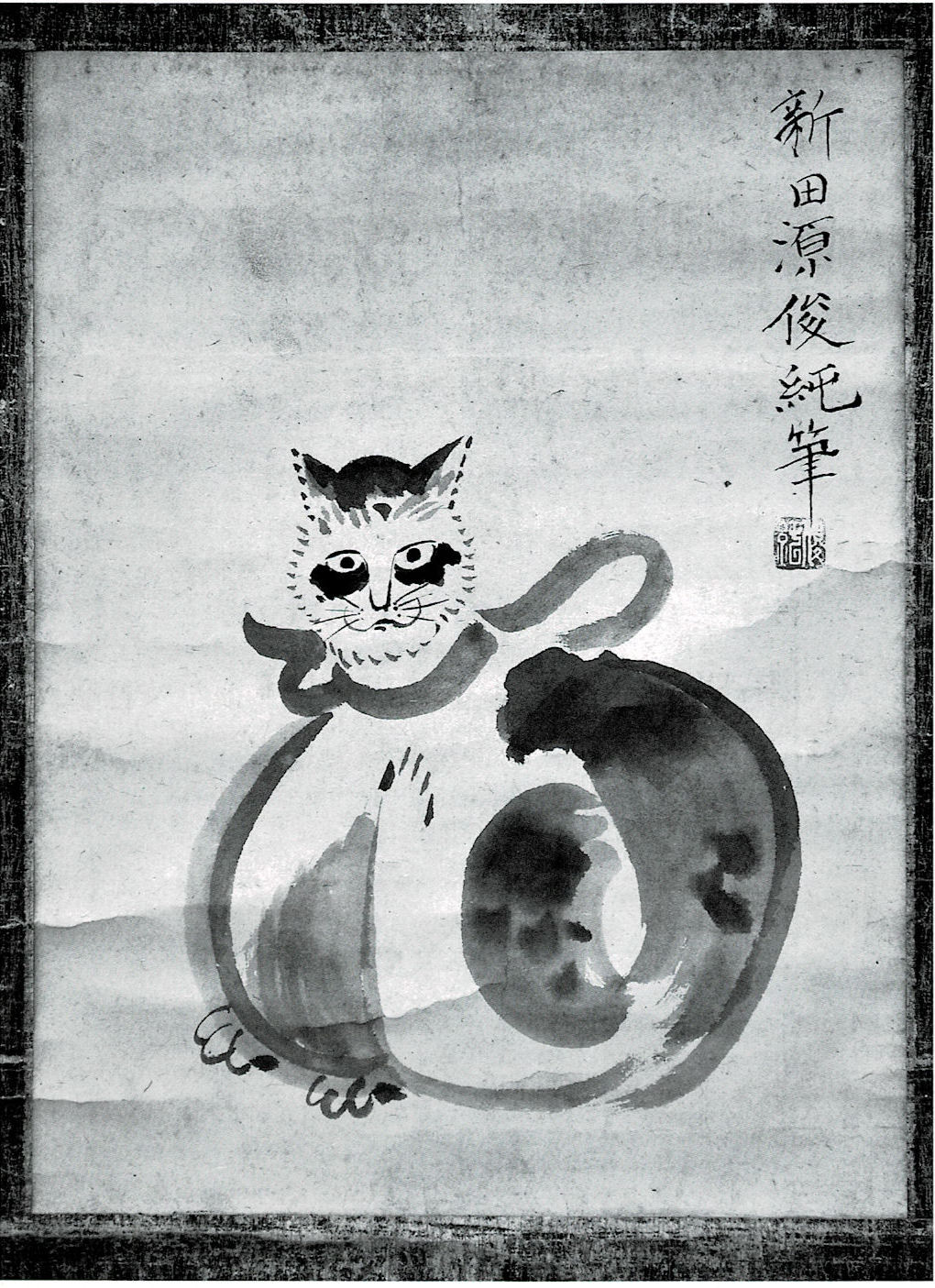
|
Figure 4 A picture of cat by Nitta. Size 41x31 cm. The letter reads, “Genuine painting by Haratoshi Nitta (新田原俊純筆)”. Stamped. Held by Nitta-sho Historical Document Library. Iwamatsu Nitta, who descended from the medieval Lord Nitta, and his and his three-generation descendants painted such a picture upon request of sericulture farmers, as a cat was believed to be useful as the natural enemy of mice. |
In Kanra District, there was a folktale of Princess Kinugasa. When the princess was resented by her bad stepmother and buried in a hole, worms of black colour arose, and when mulberry leaves were fed they grew up and one each spewed a filament to form a cocoon. The cocoons were enshrined as an example in Kinugasa Myojin.
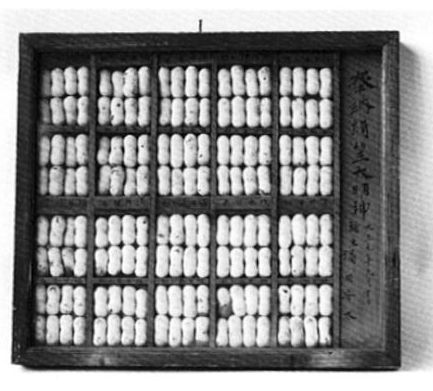
|
Figure 5 An offering to the Kinugasa-Daimyoujin (衣笠大明神), in Meishoin Temple (明照院), Shimonita Town, Kanra District.), Shimonita Town, Kanra District. |
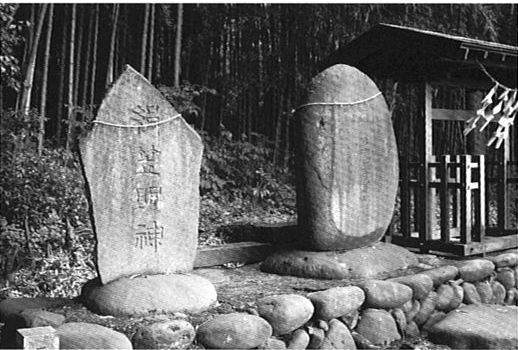
|
Figure 6 A monument of Kinugasa-Daimyoujin (衣笠大明神) in Hitsuji Shrine (羊神社) in Annaka City. The shrine is deeply related to the famous Tago Monument () in Annaka City. The shrine is deeply related to the famous Tago Monument (多胡碑) and on the right-hand side is a monument in which the tradition about Hitsuji-Dayu is described.) and on the right-hand side is a monument in which the tradition about Hitsuji-Dayu is described. |
Besides natural disasters, mice were the enemy of silkworms. Since mice devoured grown silkworms and pupae in the cocoon, people worshipped deities who would protect them, specifically cats and snakes that were the natural enemy of mice.
Sakisaki Shrine in Annaka City was widely worshiped as a sericulture shrine in a hope that silkworms would be protected from the mice, as Neko-ishi (根子石, Cat Stones) were enshrined there. In addition, the existence of a number of deities originated in folktales and legends of sericulture in various places in the prefecture has been confirmed. In my view, everything that related to sericulture became the object of worship.
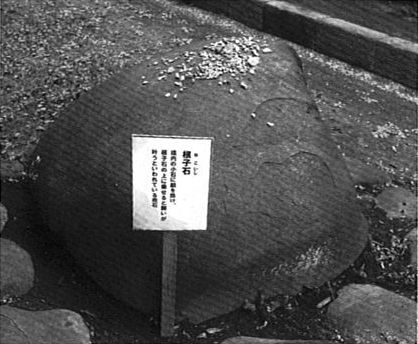
|
Figure 7 Neko-ishi (根子石, Cat Stone) in Sakisaki Shrine (咲前神社), Annaka City. It has been regarded as a guardian cat that catches mice and protects silkworms. A set of two pieces are found on the left- and right-hand side in front of the hall. It is said if one picks up pebbles in the precinct and place them on the stone, then his/her wish will come true. |
I think that the Silk God modelled into various shapes resonated with the heart of people, beyond the appearances and reasons. I may say that the heart of prayer had been thrown the soul into the shapes.
The Tomioka Silk Mill and the Deity of Sericulture
Ever since the Meiji Era, the silk industry had supported the modern nation of Japan. The economy of Gunma Prefecture was led by the silk industries that ranged from the sericulture to the silk reeling and fabric weaving, as the first governmental silk mill, “Tomioka Silk Mill”, was established in 1897. In the age when the one half of Japan’s export to Western countries was silk yarn, one-third of it was the products from Gunma prefecture.
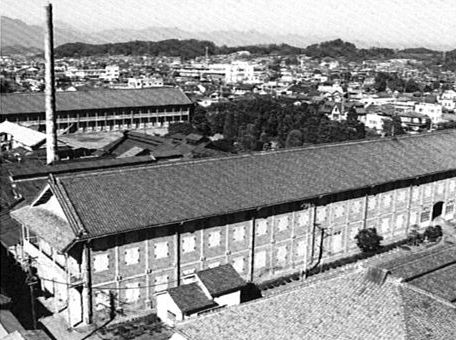
|
Figure 8 A view of Tomioka Silk Mill. The building in the front was the East Cocoon Warehouse. |
According to the Agricultural Administration Department of Gunma Prefecture, 57% of the households in the prefecture were sericulture farmers in 1890. In 1934, when it peaked, the number of the households exceeded 87,000. In 1958, the two-thirds of the farmers in the prefecture were sericulture farmers, and the number was the largest after the war. After then, the number decreased year by year, and in the 2005 survey, it was only 650 households. In such circumstances, the “Tomioka Silk Mill and Related Sites” was registered as a UNESCO World Cultural Heritage Site in 2014. In the same year, the Reeling Station and the East and West Cocoon Warehouses of the former Tomioka Silk Mill, which had been important cultural properties, were designated as National Treasures.
It was a big news, so I paid attention to it and at once conducted various investigations. Then I had postulated a hypothesis that the Tomioka Silk Mill and the deity of sericulture might have had some connection.
Unfortunately, the hypothesis was proved wrong, as no fact that linked the Mill and the deity was found. There was no episode about the sericulture worship in the explanation given by the volunteer guide at the Silk Mill. I couldn’t find anything either that looked like a monument of the deity of sericulture there. The aforementioned Mr. Sakamoto also said that there was nothing that related to the deity of sericulture god in and around the Tomioka Silk Mill.
I thought about the reason in my own brain. The Tomioka Silk Mill, the Japan’s first full-scale mechanical silk mill, was constructed under the guidance of Frenchman, Paul Brunat, and promoted modern rational method, directly importing Western ideas as they were. An extreme example can be as if a US military base were placed in Tomioka.
Even though it was in the land of Tomioka, the Silk Mill had nothing to do with Tomioka culture. Therefore, there was no room for such a domestic idea to hold a memorial services for silkworms. Also, because this silk mill had a function to teach the technology, not only to pursue commercial profit, sericulture god which bore the aspect of prosperity of business was not needed.
Sericulture worship as an Intangible Cultural Property
Although materials related to the modernisation of sericulture of old days are displayed in the Tomioka Silk Mill, nothing is touched on the thoughts and beliefs of people involved in sericulture. It may be a matter of course but, if it remains as it is, the materials about the deity of silk will be lost and the statue of the Goddess of Sericulture, damaged and then broken. When I was worried about this, a good news came.
In July 2018, the Tomioka Silk Mill World Heritage Missionary Association published a research report entitled “The deity of Sericulture in Gunma”.
The Association, established in August 2004 as a volunteer organization to disseminate the value of “Tomioka Silk Mill and Related Sites” and raise the publicity, has greatly contributed to the registration as a World Heritage Sites.
Mr. Mutsumi Machida, the leader of the survey and his team, is said to have investigated the objects of silk god worship in a systematic manner which were about to be forgotten due to the decline of sericulture industry. At the World Heritage Centre, opened next to the Tomioka City Hall in the 2nd June 2020, the basic materials used for the survey report can be viewed. They are indeed indispensable materials for the preservation of silk good items for the future.
I think that for cultural properties the crux of issue lies in how to publicise the importance of preservation and repair. Since most objects of sericulture worship are undesignated cultural properties, the task of preservation and repair is entrusted to their administrators. Those who must support them are no other than us.
Unless people in Gunma prefecture as well as those all over Japan recognise the importance of stone statues and wish them to be preserved and repaired, nothing can be done.
Registered as a World Cultural Heritage, the industry of sericulture which had once played a role as the cornerstone of Japan’s modernisation has attracted attention. This is a good chance.
In the future, I think we must continue to think over the lives and thoughts of farmers who were involved in the sericulture industry, rather than simply focusing on the tangible Tomioka Silk Mill.
Of course, it is important to preserve and maintain the building of the Silk Mill, but is not it significant to preserve and hand down the incorporeal sericulture worship that was derived from the vulnerable life of people as a cultural heritage?
<Tweet> Secret of Sericulture God
The Sericulture God was historically originated with the Memyo Bodhisattva (馬鳴菩薩) and in the modern age worshipped in the form of goddess, presumably because most people engaged in sericulture were female.
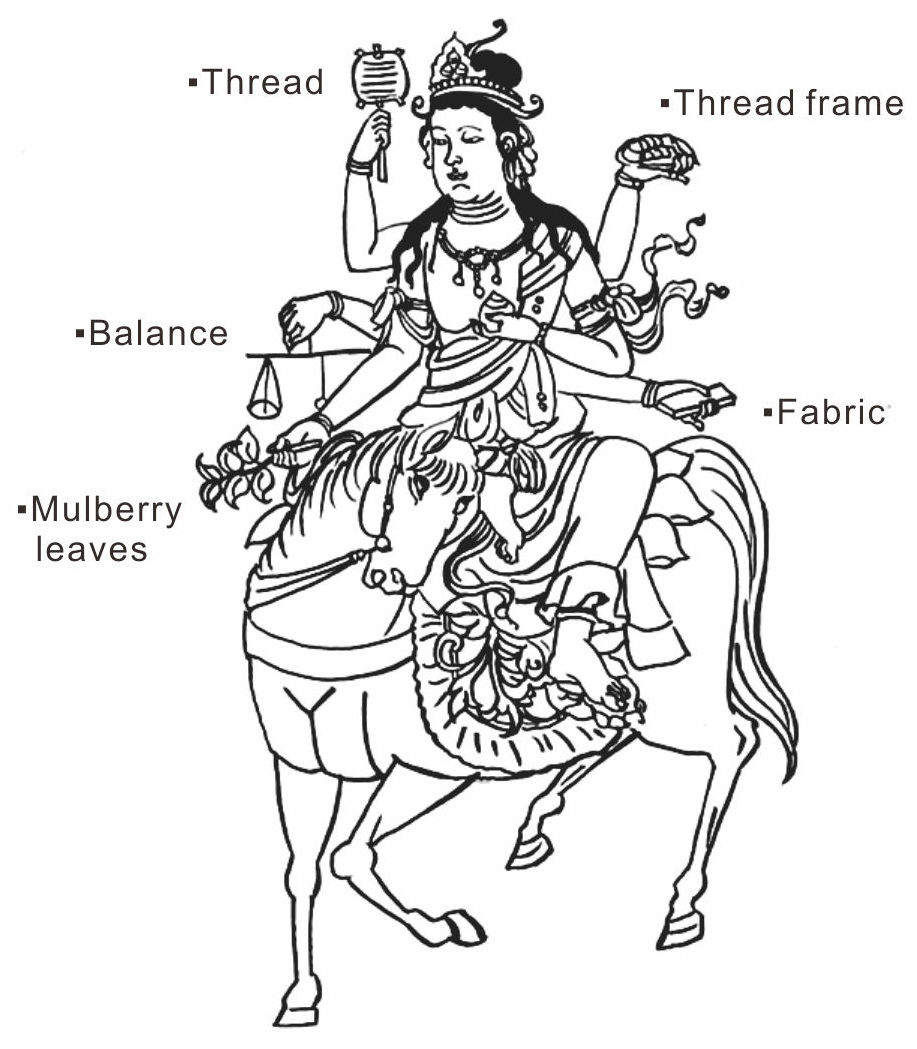
|
Figure 9a
|
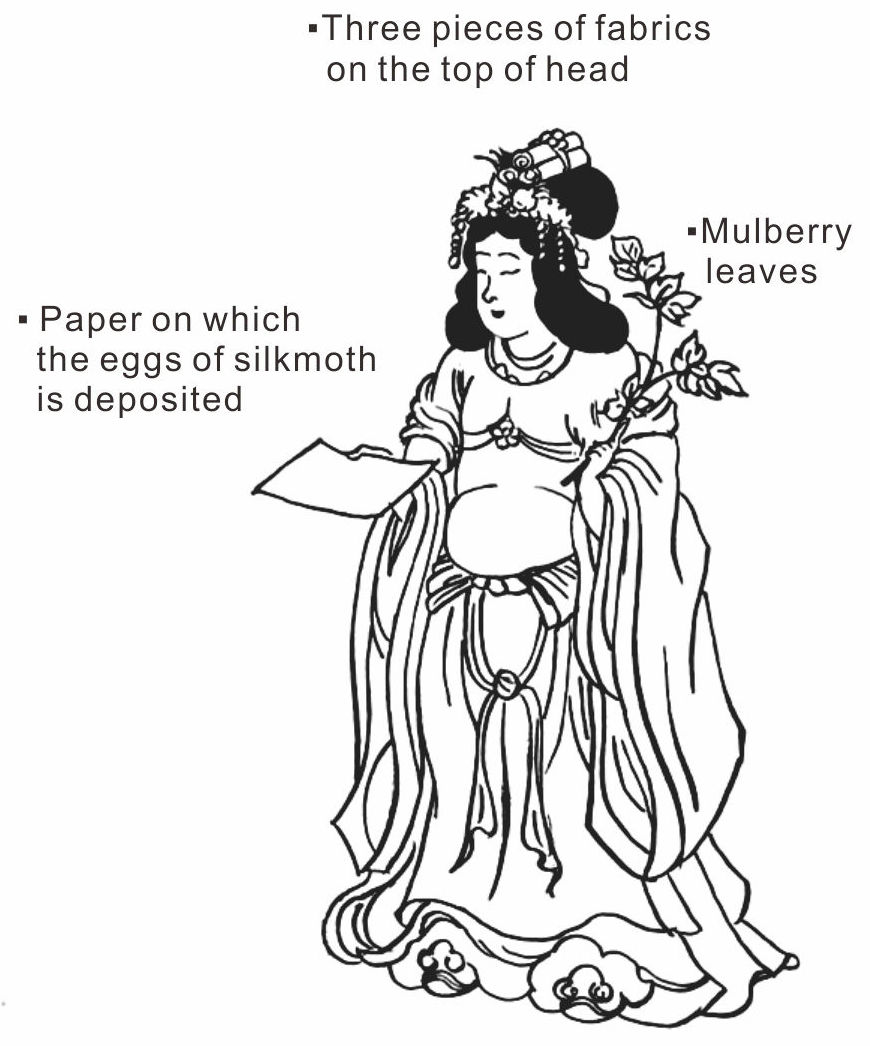
|
Figure 9b The coloured woodprints of Kinugasa Myoujin are interesting from the viewpoint of design. They are full of playful mind in such a way as silkmothes are patterned or cocoons are arbitrarily put on the clothes, some of them accompanying cats. Sculptures of Cat God carved as single units were also there. |
<Tweet> I have made a “Silkworm Divine Cat”
In sericulture worship, a cat that slays mice was regarded as a deity. Then, I have made a statue of divine cat, named “San-shin-neko”, or “Silkworm Divine Cat”.
As mentioned in the text, a Buddha statue is made not according to a rule but to the request of the client even in such a form that had not existed before. The demands of the time will create new objects of worship.
So far, I have made many statues of cat as a motif of my work. Needless to say, I am an enthusiastic cat lover. I especially like rough-tempered and bellicose male cats. I am fascinated by cats that have scars on their face and smell like a mixture of dust and fish. The statues of cats which I make are modelled after my favourite cats as such.
The thought that was inspired into the Silkworm Divine Cat was my acknowledgements to the Tomioka Silk Mill and the heart of people that had led Japan to become an economic power.
In addition, I have made the model pieces of Silkworm God. A silkworm that has grown up to silkmoth is blind and deaf, and has no mouth to eat, the mission of which being to leave offspring.
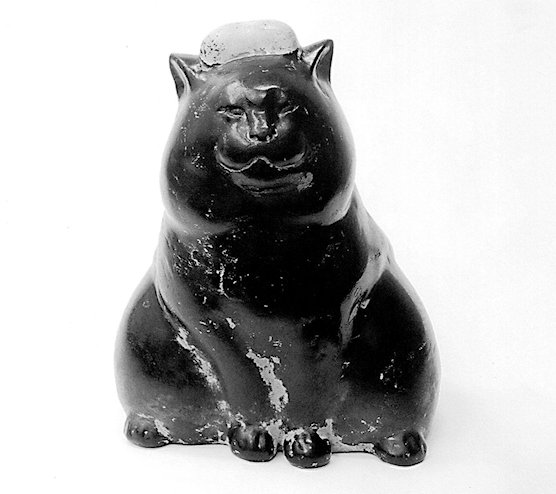
|
Figure 10 |
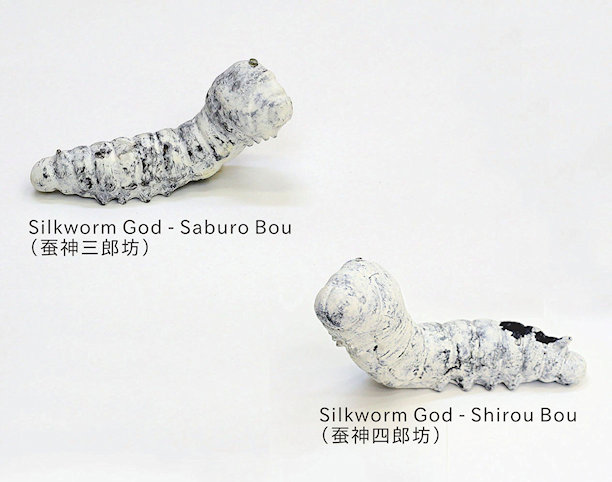
|
Figure 11 |
I also wish to thank silkworms that provide silk. I have put a white urna, the Buddha’s eye, to the forehead of silkworm statues, to imagine that they are the familiars of the god.
Gunma Prefecture is famous, for Dharma [10] figures. So I have recently have produced a Silkworm Divine Cat Dharma Figure to liven up the Tomioka Silk Mill that is now a World Cultural Heritage, wishing them to be an advertising mascot of sericulture worship.
The point is that it is a playful figure. I wish you will have better understanding about the sericulture worship by delivering the replicas of Silkworm Divine Cat Dharma Figure to everyone. It is a figure for prayer as the common Dharma figure is.
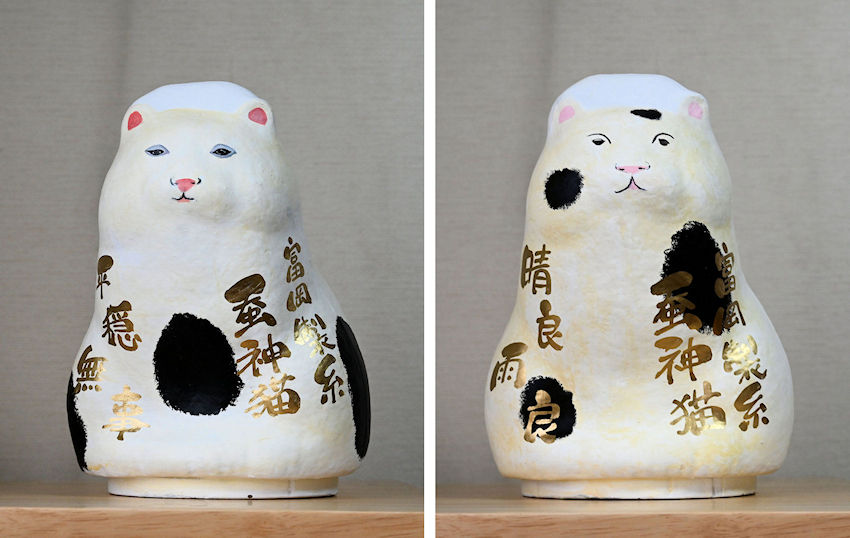
|
Figure 12 |
[1] Sets of dolls to celebrate the growth of girls on the 3rd of May.
[2] “o-“, a prefix to noun for courtesy.
[3] “-sama”, a suffix to proper noun, for courtesy, used for both male and female.
[4] A history book of Japan, compiled in 720 AD.
[5] A history book of japan, complied in 712 AD, regarded as the first of its kind.
[6] In Kojiki, the god whose body generated silkworm, rice plant, millet, redbeans, soybeans etc., was Ōgetsuhime (大宜都比売神, Goddess Ōgetsu), and the murderer was Susanowo-no-mikoto (素戔嗚尊, God Susanowo). https://www.kokugakuin.ac.jp/article/90580..
[7] January 2007.[7] January 2007.
[8] Literary, Silk-hat Grace-god.
[9] In the mid-6th Century, 538 or 552 (?).
[10] Abbreviation of Bodhidharma. Bodhidharma, a Buddhist monk of the late 5th to the early 6th c. of Indian origin, who went to China, is frequently depicted limbless as his arms and legs were said to have degenerated while sitting against a rock wall and practicing asceticism for fourteen years at Songshan Shaolin Temple (嵩山 少林寺).